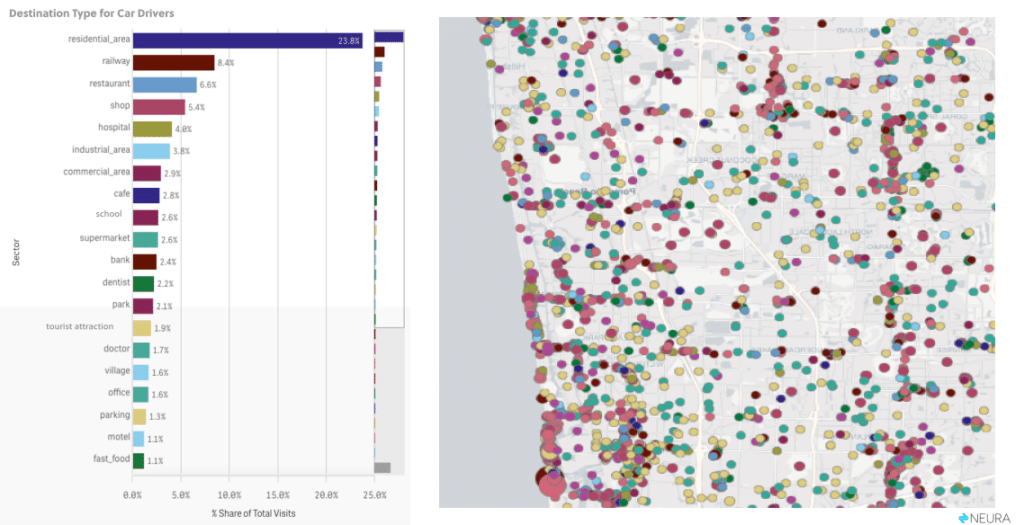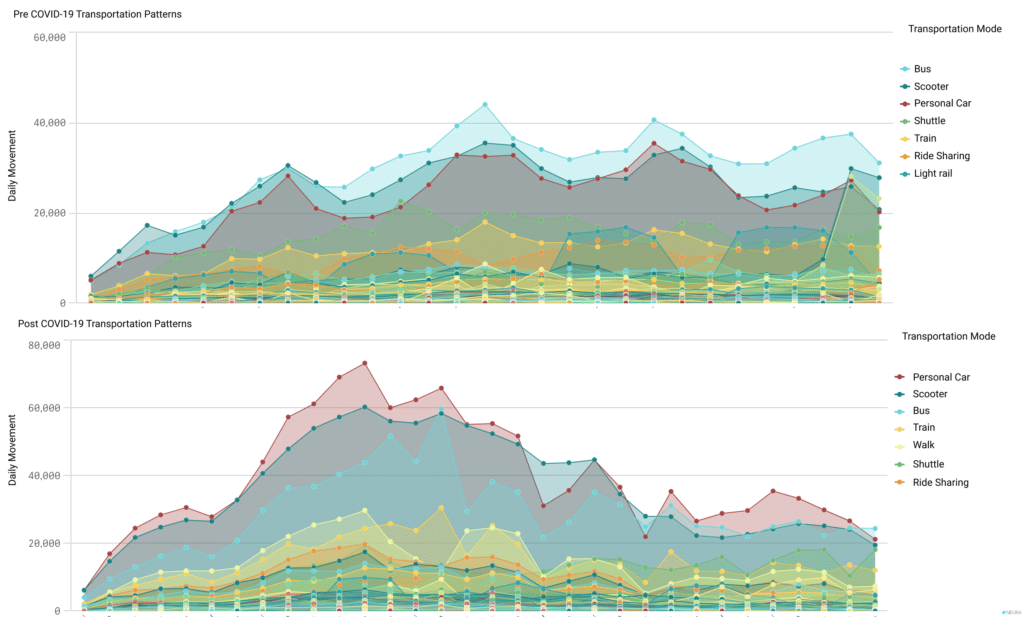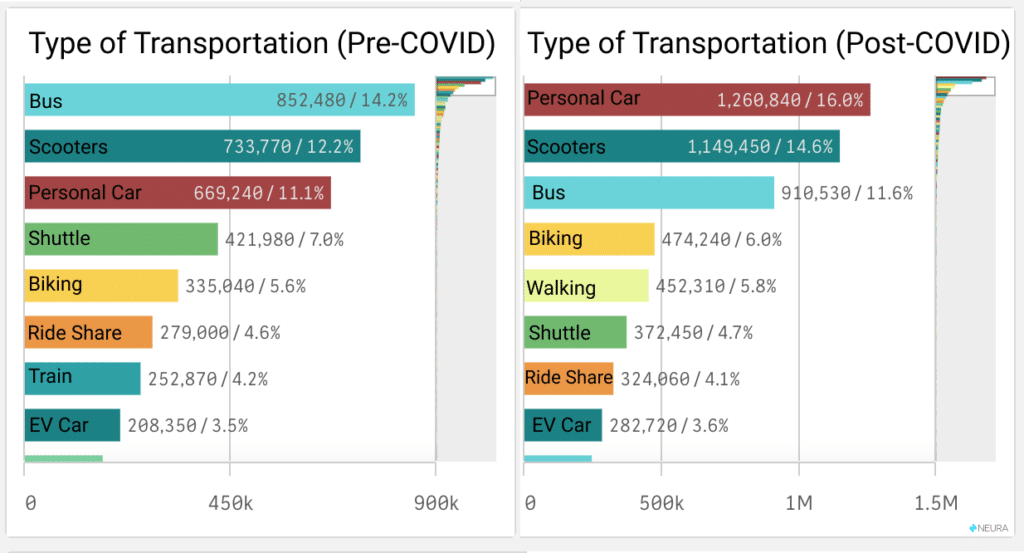
Introduction
As our cities and societies begin the slow process of recovery from the COVID-19 pandemic, it is a good time to reflect on what has passed over the course of the previous months, and to better understand the many transformations that have taken place. This will give us a perspective in which to determine our path forward, in the return to normal in our cities, with regards to urban mobility and movement in general. In addition, during this period of time, countless cities across the globe used the pandemic as a basis in which to physically intervene in temporary programs and investments that would promote social distancing and encourage active modes of transportation.
Urban Design Interventions & Typologies
We have seen a variety of urban design interventions and typologies introduced during the COVID-19 pandemic by cities. It will be good to have a review of some of the most common forms we have seen, and their impact at a local level:
- Pop Up Bike Lanes – Also known as corona cycle path and is in this meaning an emergency bike lane set up at short notice to quickly provide more space and safety for cyclists in an acute danger or crisis situation or in the event of sudden changes in road traffic conditions.
- Pedestrian Paths – A prepared exterior or interior way of passage provided for pedestrian travel. Includes independent walkways, shared-use paths, sidewalks, and other types of pedestrian facilities. All pedestrian circulation paths are required to contain a continuous pedestrian access route that connects to all adjacent pedestrian facilities, elements, and spaces that are required to be accessible.
- Outdoor Dining – Programs for restaurants to create seating on the sidewalks and streets in front of their establishments, with some cities and organizations even providing funding to help them with the transition.
- Public Spaces & Parks – This pandemic made us realize the value of reachable open spaces that allow movement within dense urban areas. Physical isolation with absence of adequate open spaces is one of the major causes of discomfort and poor living conditions.
- Open Streets – Some streets can be designated completely for walking and running while maintaining distance and reduce crowding on roads and streets. Several cities in the world have stopped cars and pedestrianized streets as a social-distancing measure.
- 15 Minute Cities – residential urban concept in which all city residents are able to meet most of their needs within a short walk or bicycle ride from their homes. The concept was popularized by Mayor Anne Hidalgo, who was in turn inspired by French-Colombian scientist Carlos Moreno. It has been described as a “return to a local way of life.”
Shift to Active Transportation
An effective way to stimulate physical activity during the COVID-19 pandemic has been to promote the choice for active modes of transport (walking and cycling). Over the past year, several interventions and policies have been implemented to stimulate this mode shift. Such interventions have been implemented locally using cross-sector collaboration and shared decision making based on addressing local barriers to change and identifying those strategies likely to be most impactful. Local governments have understandably been focused on the COVID-19 public health response, but further action to drive infrastructure change and embed it with behavioral change interventions is needed. This has strengthened the narrative that walking and cycling are safe in the context of social distancing and that these alternative transport methods are also of benefit in potentially reducing COVID-19 mortality risk factors such as type 2 diabetes.
COVID-19 Multimodal Landscape – The transportation landscape has been affected across all modes as a result of the COVID-19 pandemic. Each and every mode has seen either a decline, shift, or readjustment related to disruptions in daily movement patterns.
- Cycling and Walking – The COVID-19 pandemic represented an opportunity to accelerate a radical rethinking of space and the ways for moving in it. In terms of distance undertaken for commuting, 36.2% of Europeans travel fewer than 10 km, therefore making a switch to walking and cycling for this segment a feasible option.
- Public Transport – The restrictive measures and the negative perception of the potential risk associated with the use of public transport have entailed serious losses for public transport companies. Shared mobility services were also affected by the crisis, namely during lockdown.
- Shared Mobility – The risk of contagion due to the contact of different users with the same surfaces has discouraged the use of e-scooters, bicycles, mopeds, ride hail and carshare offers.
- Logistics & Freight – Fragmentation in urban logistics loads and trips is accentuated by the recent expansion of e-commerce and instant deliveries and further accelerated by the COVID-19 lockdown, contributing to an increase in the number of deliveries and in terms of environmental impact, and adding new types of soft modes (cargo-bikes, scooters) for freight movements.
Mobility Intelligence Insights
We understand that mobility companies and public transportation companies alike equally want to understand who their riders are, what their needs are, and how to gain more high usage riders. Being able to identify their users’ needs is essential in increasing their ridership and providing real value to their customers.
This is where Mobility Intelligence fits in. We provide real-life demand and persona insights enabling mobility companies to anticipate and qualify demand, resulting in cost effective planning and maximized revenue.
For companies hoping to get an upper hand post pandemic, answering questions like those below are crucial:
- Where are riders coming to and from?
- What time of the day is there the most need for your services?
- What areas and zip codes are in most demand?

This graph shows a granular breakdown of demand per hour based on the neighborhood which can help inform mobility companies and public transport for where to place more drivers, scooter services, or more pick up stations for buses or trains.
Further, our insights share where it is that people are going in their personal vehicles which helps tell city planners, mobility companies, and public transportation companies alike which areas are in highest demand by individual travelers which can help inform areas that may be more fit for open streets, pop-up bike lanes, outdoor dining, and more, all key insights that can continue the momentum COVID-19 brought for post-pandemic city living.

Our Mobility Intelligence platform focuses on empowering businesses to drive strategic, data-driven decisions by transforming vast amounts of anonymized data and activity signals into actionable, impactful, and monetizable insights.
Our customers in the mobility and urban intelligence space tell us that the insights we provide have been integral to staying as up to date as possible on micro and macro level mobility trends that can be easily extracted and utilized to make decisions impacting city planning, mobility routes, and quick changes to increase city livability.
Previously, most mobility and urban planning companies relied on outdated census information or very minimal survey data to gather information about population movement, source and destination insights, and hot spots of movement, this made such city changes e.g. bike line integration, pedestrian dining expansion, park creations etc., a much slower process from inception to fruition. Utilizing a data network, insights into mobility allows for decisions on city planning and optimization as seen and accelerated during the peak of the COVID-19 pandemic, to continue to carry speed and momentum.
Comparative Multimodal Data Analysis – Bike, Scooter, Walking, Public Transit, Carshare
After analyzing the data across major cities including Miami, London, and Tel Aviv our behavioral intelligence platform discovered a clear trend in movement changes directly validating the increase in urban design inventions and typologies.
Our data analysis consisted of dissecting the different transportation modes by type differentiating between the social modes of transport such as bus, shuttle, ride sharing, light rail, and train, and the private modes of transport known as scooters, bikes, walking, and personal cars. The social modes of transportation took a direct hit during the COVID-19 pandemic in direct correspondence to the increase in private modes of transport.
Below we see pre and post coronavirus modes of transportation by prevalence, with buses dominating the pre-COVID-19 method of transportation and personal car taking center stage, post COVID-19 peak.

This backs up the initial argument that active transportation was greatly impacted by the pandemic as modes of transportation like walking, biking, and scooter riding became much more frequented ways of getting around cities.
In another graph we can see this on a more granular level based on specific modes of transportation. We can see below that the use of buses dramatically decreased, as active modes of transportation took their place, as well as personal cars for those returning to the office. This was directly inline with the large spike in personal car purchases and lack of bus riders.

Across the major cities we analyzed and rural towns we saw the same trend: a decrease in social, stagnant modes of transportation, and an increase in agile, active mobility modes.
An important question is how we maintain the high level of active transportation and give people the confidence to incorporate this with more social modes of transportation.
MaaS to Enabled Multimodality & Active Transportation
Mobility as a Service is seen as a key digital enabler in promoting active transportation and multimodality, post COVID-19. For example: Iomob’s platform enables regional and local Public Transport Authorities, and Municipalities to orchestrate MaaS ecosystems that achieves the goals of emissions and congestion reduction, fewer car journeys, and increased active travel. Iomob provides an open and interoperable marketplace with deeply integrated public and private mobility services for cities and regions. Iomob’s mobility-on-demand platform for cities and regions facilitates seamless, multimodal travel through access to an extensive open network of mobility service providers (MSPs).
Besides offering an increasing number of clean mobility choices, Iomob is developing a net-zero carbon travel option through which users can choose to voluntarily pay for carbon offsets when booking a multimodal journey. What makes this carbon offset scheme unique is that the offsets are applied locally, giving the user a sense of directly improving the community in which they live and travel. For those who cannot afford to absorb the cost of purchasing emissions offsets, Iomob is currently working on implementing micro-subsidies of carbon offsets.
In Conclusion
As we have noted, the COVID-19 pandemic has proven a unique opportunity for policymakers and urbanists to better understand data, movement patterns, and modal shift in general. There has been a transformation which has incorporated all actors in the urban ecosystem, related to a rethinking of how our cities and societies are to recover economically, socially and environmentally post pandemic.
By utilizing deep real-time, real-world movement insights from around the world, municipalities and commercial companies alike are able to understand the needs of the citizens in the local area in order to provide the best services to meet the needs presented, whether that’s additional bike lanes, open streets, outdoor dining, or an increase in pedestrian paths, mobility intelligence provides a key framework for understanding movement behavior to increase sustainability in cities and foster more livable, easy to maneuver, value-added cities for residents globally.
Are you interested in learning more about Mobility intelligence and its impact, schedule a chat with one of our data experts here.













More Stories
New future-ready single-slot PXIe controller for high-performance T&M applications from Pickering Interfaces
US Army Awards ANELLO Photonics Contract Phase II SBIR Topic “xTech Search 7 SBIR Finalist Open Topic Competition”
E Tech Group Named Platinum Partner in Rockwell Automation PartnerNetwork